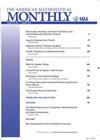Wald恒等式与尾和公式
IF 0.4
4区 数学
Q4 MATHEMATICS
引用次数: 0
摘要
n=1P(n≥n)。这里第一个等式是合理的,因为∑N=1Xn=∑∞N=1XnI{N≥N};二是因为Xi是非负的;三是因为N独立于Xi;最后一个原因是Xi是同分布的-Reza Farhadian,拉兹大学和Vadim Ponomarenko提交,圣地亚哥州立大学doi.org/10.XXX/amer.math.monthly.122.XX.XXX MSC:Primary 60C99本文章由计算机程序翻译,如有差异,请以英文原文为准。
Wald’s Identity vs. Tail Sum Formula
n=1 P(N ≥ n). Here the first equality is justified because ∑N n=1 Xn = ∑∞ n=1 XnI{N ≥ n}; the second because the Xi’s are nonnegative; the third because N is independent of the Xi’s; and the last because the Xi’s are identically distributed. —Submitted by Reza Farhadian, Razi University and Vadim Ponomarenko, San Diego State University doi.org/10.XXXX/amer.math.monthly.122.XX.XXX MSC: Primary 60C99
求助全文
通过发布文献求助,成功后即可免费获取论文全文。
去求助
来源期刊

American Mathematical Monthly
Mathematics-General Mathematics
CiteScore
0.80
自引率
20.00%
发文量
127
审稿时长
6-12 weeks
期刊介绍:
The Monthly''s readers expect a high standard of exposition; they look for articles that inform, stimulate, challenge, enlighten, and even entertain. Monthly articles are meant to be read, enjoyed, and discussed, rather than just archived. Articles may be expositions of old or new results, historical or biographical essays, speculations or definitive treatments, broad developments, or explorations of a single application. Novelty and generality are far less important than clarity of exposition and broad appeal. Appropriate figures, diagrams, and photographs are encouraged.
Notes are short, sharply focused, and possibly informal. They are often gems that provide a new proof of an old theorem, a novel presentation of a familiar theme, or a lively discussion of a single issue.
Abstracts for articles or notes should entice the prospective reader into exploring the subject of the paper and should make it clear to the reader why this paper is interesting and important. The abstract should highlight the concepts of the paper rather than summarize the mechanics. The abstract is the first impression of the paper, not a technical summary of the paper. Excessive use of notation is discouraged as it can limit the interest of the broad readership of the MAA, and can limit search-ability of the article.
 求助内容:
求助内容: 应助结果提醒方式:
应助结果提醒方式:


